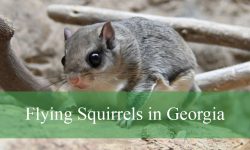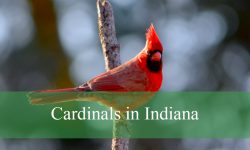Tiny red spiders are fascinating to both nature lovers and casual viewers in the vast world of arachnids. These colorful animals, which are sometimes disregarded because of their diminutive size, have an amazing variety of colors and patterns that make them both fascinating and lovely.
This article delves into 37 tiny red spider species, complete with captivating pictures and identification tips to help you appreciate these remarkable arachnids in their natural habitats.
Different Types of Tiny Red Spiders
Small Thief Spider
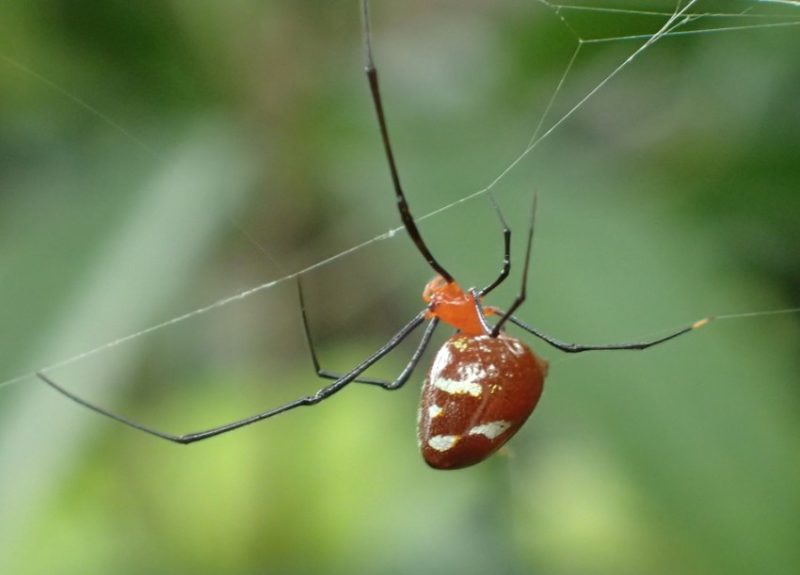
The Small Thief Spider (Argyrodes miniaceus) is one of the smallest red spiders in the U.S., growing up to 4.5mm. It is characterized by its distinct red coloring with white markings on the abdomen, while its cephalothorax is also red but smaller in size. The long, thin legs are black.
This species is known as a parasitic spider, often found on the webs of other spiders, particularly orb weavers, from which it steals trapped insects. The vivid coloring and agile movements of Small Thief Spiders can attract flies to the host’s web, making them tolerated by their hosts.
Spotted Cobweaver
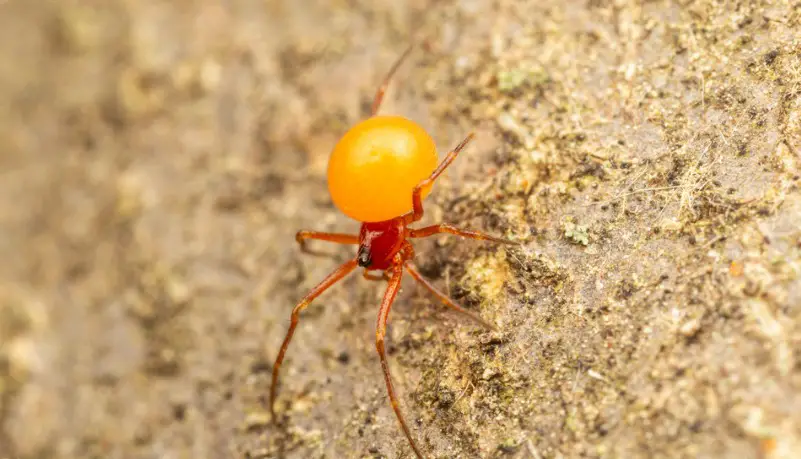
The Spotted Cobweaver (Thymoites unimaculatus) is a common spider found in North America, belonging to the Theridiidae family, characterized by comb-like bristles and sticky webs rather than woolly ones. These red spiders exhibit slight color variations between the sexes, with the cephalothorax and legs being predominantly red. Their dome-shaped abdomen is typically orange; females display a distinct red mark, while males have a uniform orange abdomen.
Due to their small size, Spotted Cobweavers can be challenging to detect, as they prefer habitats like shrublands and forests.
Woodlouse Spider
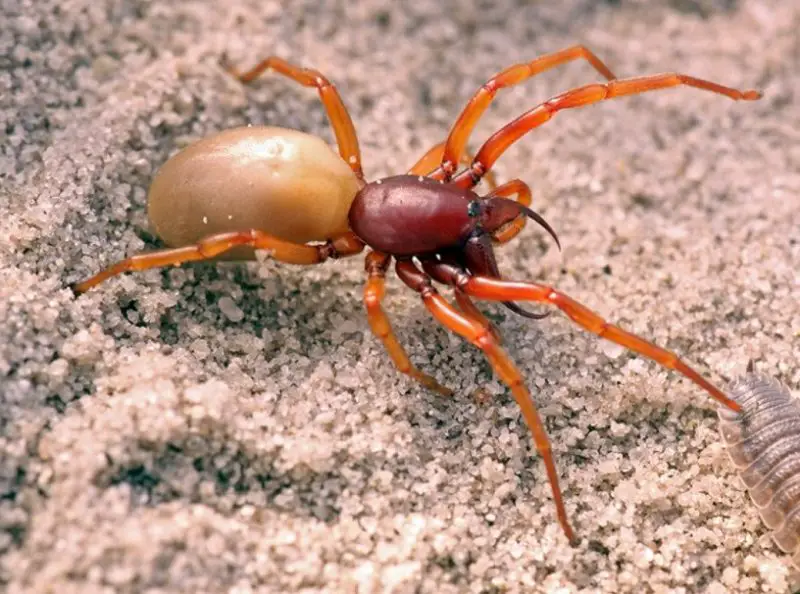
The Woodlouse Spider (Dysdera crocata) is commonly found in homes, known for its red-brown cephalothorax and tan abdomen. Females can grow up to 15mm, while males reach about 10mm.
It has distinctively long mouthparts, allowing it to efficiently hunt prey like woodlice, roaches, and other spiders. With red or brown-red legs, the Woodlouse Spider is an effective predator indoors, using its large mouthparts to immobilize its prey.
Red House Spider
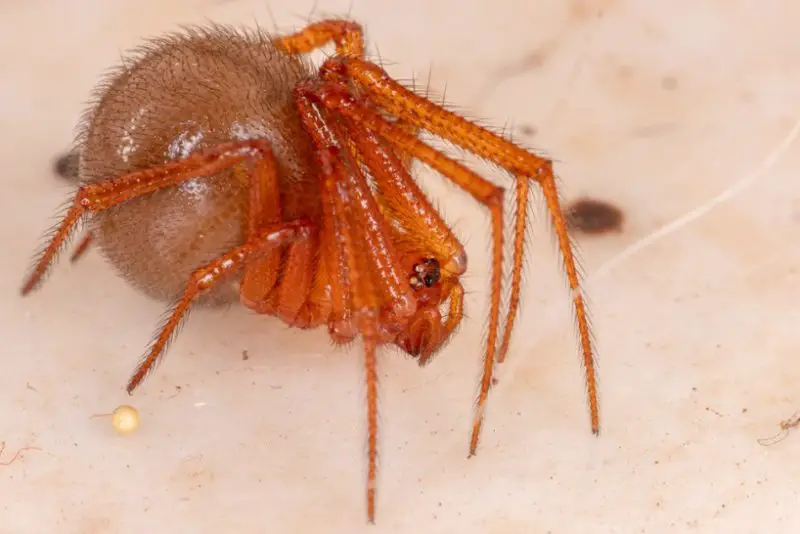
The Red House Spider (Nesticodes rufipes) is a venomous species known for its painful bite, often compared to that of the Redback spider. It has a red or red-brown body, with a bulbous abdomen and shiny dark red legs.
Common in warm environments, it builds webs in hidden areas of homes, such as behind furniture or in corners. These webs attract insects, providing food for the spider. Though its bite is painful, Red House Spiders are more elusive, avoiding direct sunlight.
Broad-Faced Sac Spider
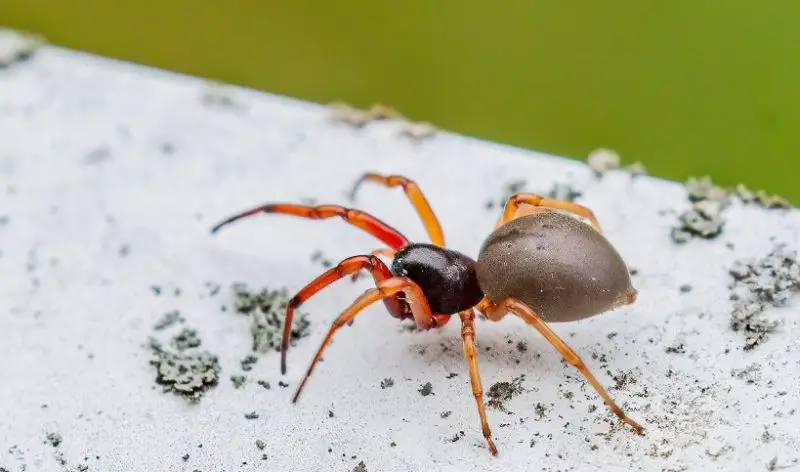
The Broad-Faced Sac Spider (Trachelas tranquillus) is a small species with a dark red-brown cephalothorax, bright red legs, and a muted gray abdomen. Males grow to 5-6mm, while females reach 7-8mm.
Though smaller than other red house spiders like the Woodlouse spider, the female Broad-Faced Sac spider’s bite is painful and can lead to infections requiring medical attention. These spiders are commonly found indoors and should not be touched due to the risk of their venomous bite.
Black-tailed Red Sheetweaver
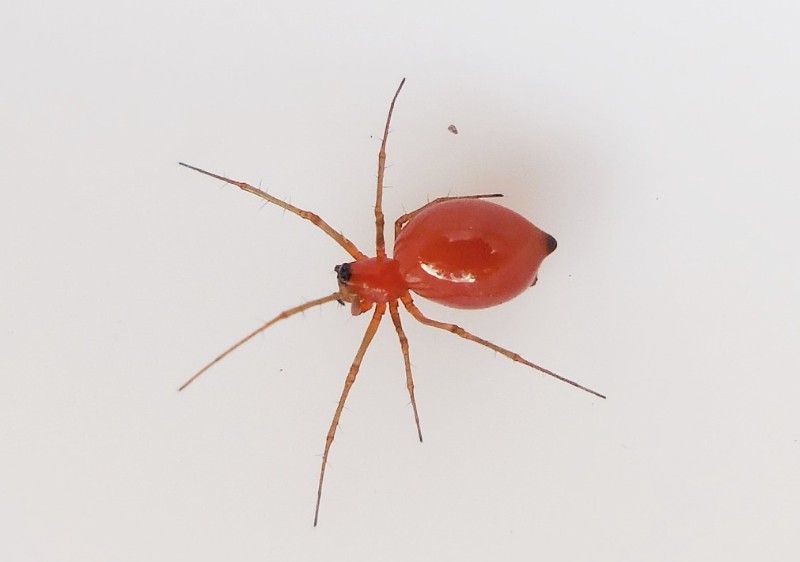
The Black-tailed Red Sheetweaver (Florinda coccinea) is a tiny red spider, reaching just 3-4mm in length. It has a bright red cephalothorax and abdomen, with a shiny outer layer and long, thin black legs. Black markings may appear on the female’s head and the tip of the abdomen.
Color variations exist, with some individuals having a darker red cephalothorax compared to their lighter red abdomen. Though small, it is commonly found in homes, often unnoticed due to its size.
Black-banded Crab Spider
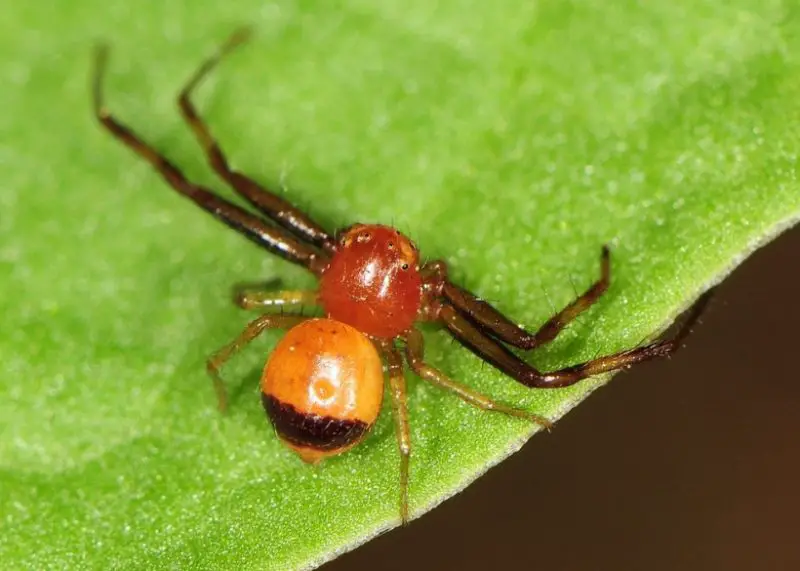
The Black-banded Crab Spider (Synema parvulum) is named for the black stripe on its rear. It has a red-brown abdomen, a light red cephalothorax, and dark red front legs, while the rear legs are lighter. Known for its crab-like sideways movement, this spider is beneficial in gardens, preying on pests like aphids.
Despite its outdoor preference, it often moves indoors from gardens, where it continues to control invasive species. Its presence is usually seen as helpful for plant protection.
Bull-headed Sac Spider

The Bull-headed Sac Spider (Trachelas pacificus) is commonly found in and around homes, with a red upper body, red legs, and a gray or olive-gray abdomen. Females grow to 7-10mm, while males reach up to 6mm.
These venomous spiders are known for scavenging insects, which can lead to the transmission of infections. Often tied to man-made structures, they may nest in wood piles and venture indoors in search of live or dead insects, making them a frequent household species.
Comstock’s Wafer Trapdoor Spider
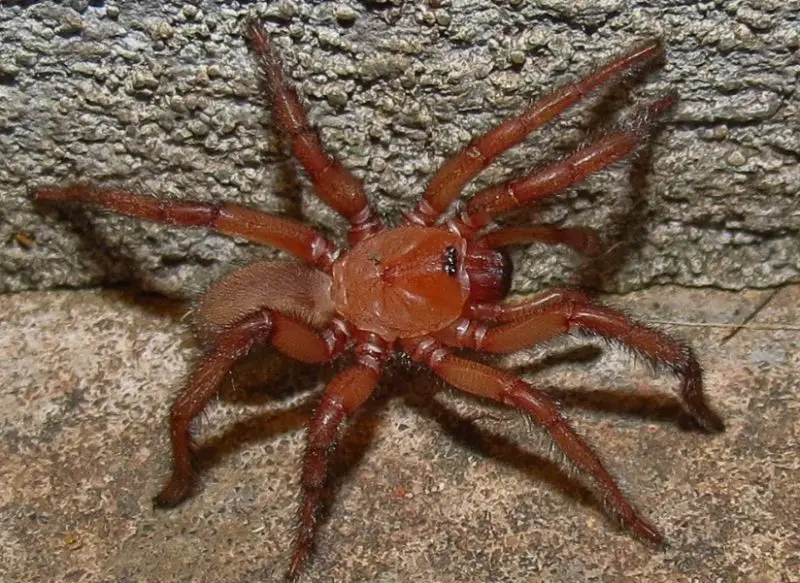
Comstock’s Wafer Trapdoor Spider (Myrmekiaphila comstocki) is a bright red spider found mainly in the Southern U.S. and Mexico. It has a vivid red cephalothorax, a hairy red abdomen, and thick red legs covered in short black hairs. A small black mark on the head matches the black hairs on its legs.
Larger than many spiders entering homes, it can climb walls, often attracted to lights where it hunts insects. This species is commonly seen near homes, especially where insect prey is abundant.
Red Widow
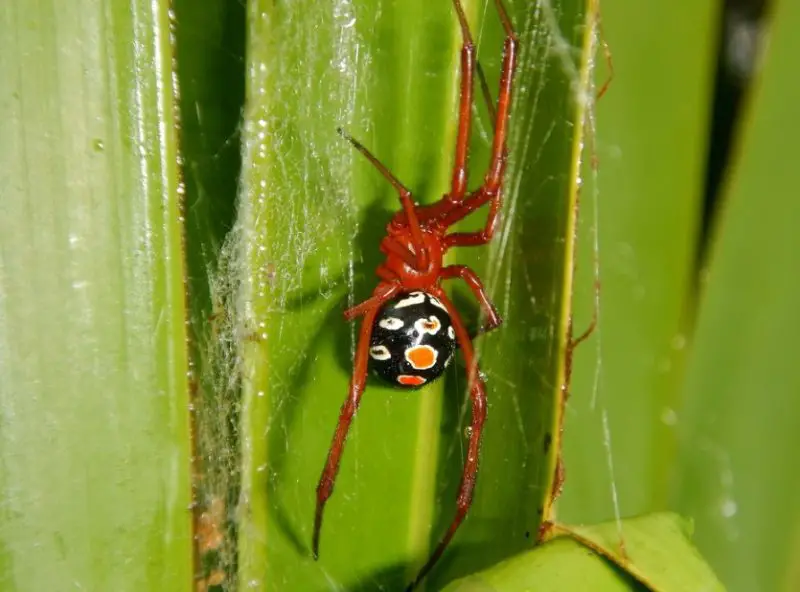
The Red Widow (Latrodectus bishopi) is a venomous spider often mistaken for Black Widows. It has red legs, a black abdomen, and a distinct red mark or two red spots on the abdomen, but lacks the characteristic hourglass marking of Black Widows.
Found mainly in Florida’s sandy areas, Red Widows prefer to avoid human contact, though their bite is dangerous. They are typically found in parks, gardens, and front yards with palm bushes. Red Widows should not be handled, as they may bite when threatened.
Common Triangular Spider
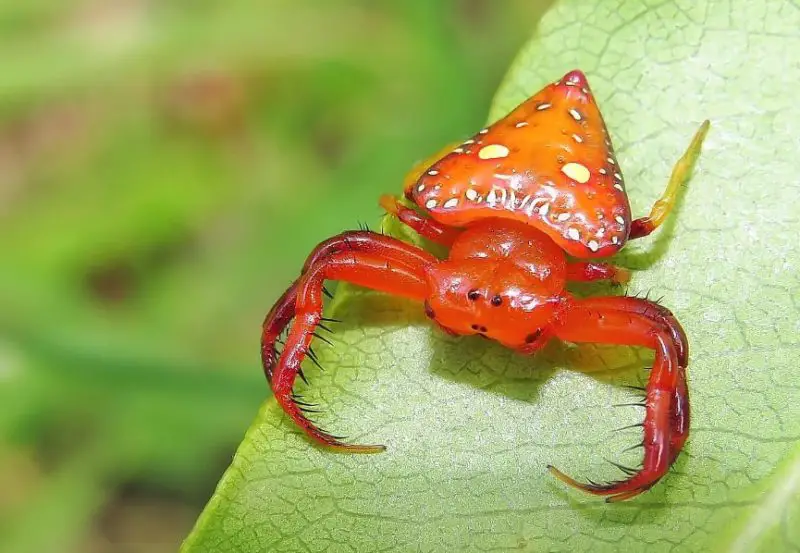
The Common Triangular Spider (Arkys lancearius) is easily recognizable by its unique triangle- or heart-shaped abdomen, which features a pointed rear resembling an arrow tip. This species predominantly displays a red coloration with orange tones near the abdomen, accented by white markings bordered in black.
Notably, it has pale yellow rear legs contrasted by vibrant red front legs. While non-venomous, these spiders do not construct webs; instead, they are nocturnal hunters, often seen during the day using their long front legs to capture unsuspecting insects.
Red Tent Spider
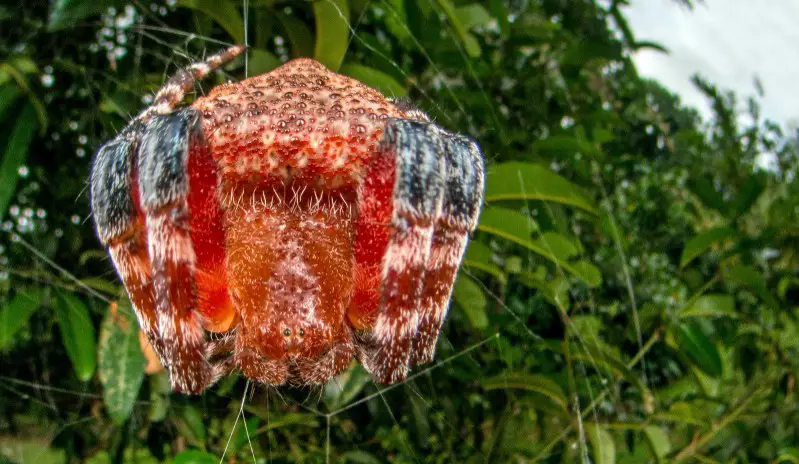
The Red Tent Spider (Cyrtophora unicolor) is distinguished by its striking bright red and dark red color morphs, featuring red legs and a unique yellow and red abdomen. Males typically have an almost uniform red body, though they appear darker than their female counterparts.
This spider is particularly known for its irregularly shaped, multi-dimensional webs, which are highly effective for trapping insects. The female Red Tent Spider often resides at the center of the web and adeptly moves to either side to capture prey ensnared in the delicate threads.
Red-and-white Asagena
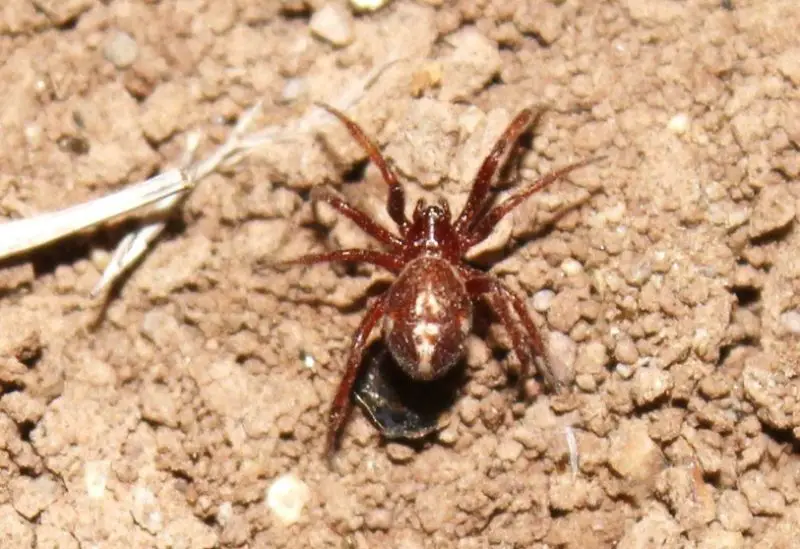
The Red-and-white Asagena (Asagena fulva) is a distinctive spider belonging to the Theridiidae family, similar to the Spotted Cobweaver. Characterized by its mostly red coloration, it features a darker red cephalothorax and a slightly brighter red bulbous abdomen.
This species displays unique abdominal markings, including a central irregular white line bordered by another white line. Commonly found in the Southern United States, particularly in arid terrains, Red-and-white Asagenas are also present in Mexico, making them a notable sight in these regions.
Emerton’s Bitubercled Cobweaver
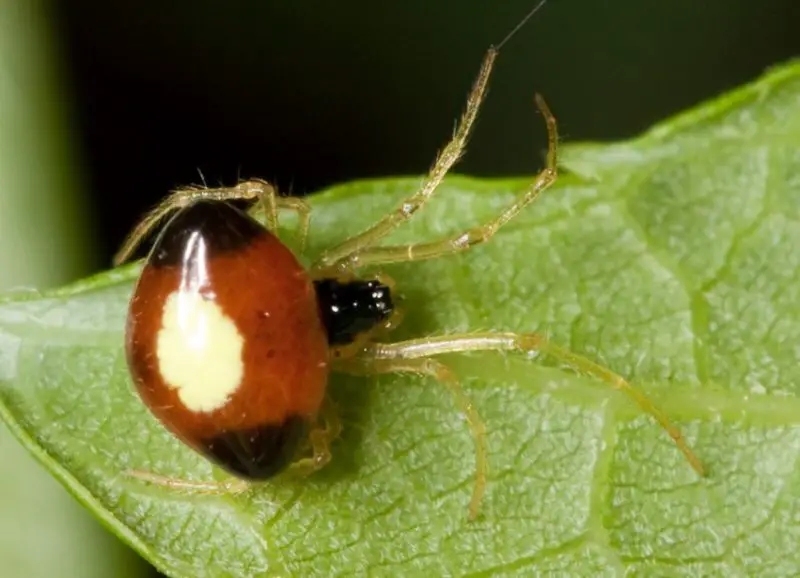
Emerton’s Bitubercled Cobweaver (Theridula emertoni) is one of the smallest red spiders in the world, with adult females measuring as small as 1.7mm and males at 1.6mm.
The species is characterized by a dome-shaped abdomen, which is its largest body part, displaying a faded red color with two lateral black marks and a central yellow spot. Its legs are pale yellow or pale orange, while the cephalothorax is predominantly black.
Commonly found in woodlands, parks, and gardens, these spiders can often be seen on leaves or plant stems, with males exhibiting a distinct color variation that includes a black abdomen and one or multiple yellow markings.
Cornfield Bolas Spider
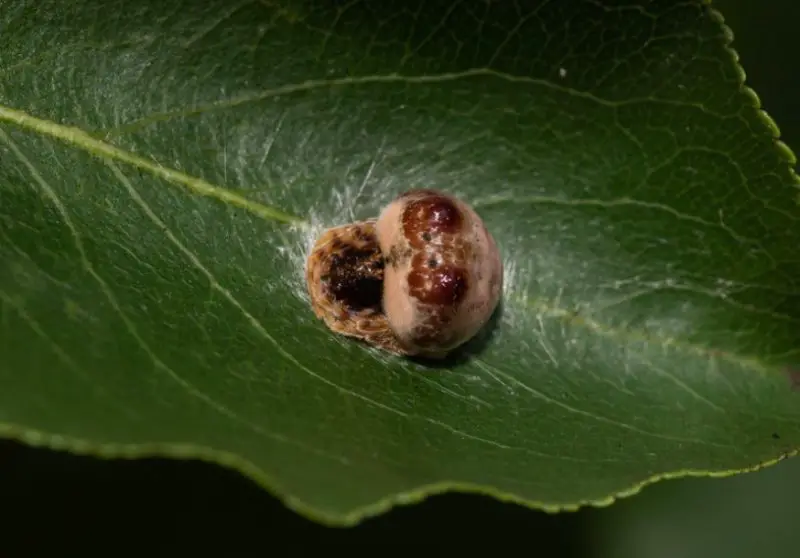
The Cornfield Bolas Spider (Mastophora hutchinsoni), also known as the American Bolas Spider, is notable for its unique diet and hunting techniques. Females have a dark brown body, while males display vibrant red to blue coloring.
As nocturnal hunters, these spiders primarily prey on moths but possess poor vision, making them reliant on alternative methods for locating their food. They emit a chemical odor that mimics the scent of moths to attract them.
Additionally, the hairs on the females’ legs can detect vibrations, allowing them to sense passing moths more effectively.
Silvestri’s Cave Spider
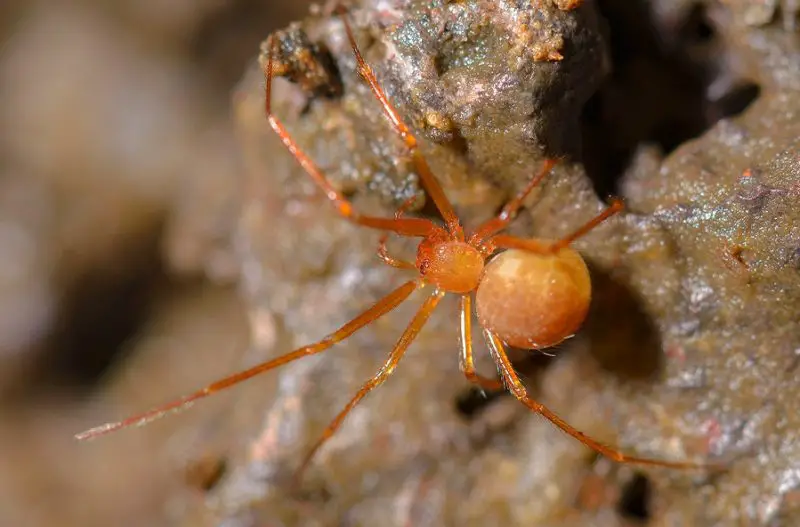
Silvestri’s Cave Spider (Nesticus silvestrii) is commonly found in the northern U.S., with a red or brown-red coloration that varies depending on its habitat. Darker-colored spiders are more likely to inhabit caves, while bright red morphs are often found on crops, in gardens, and occasionally indoors.
This species also has light brown and tan morphs, all sharing a uniform color. Silvestri’s Cave Spiders are adapted to various environments, ranging from caves to human dwellings.
Prairie Ant-mimic Sac Spider
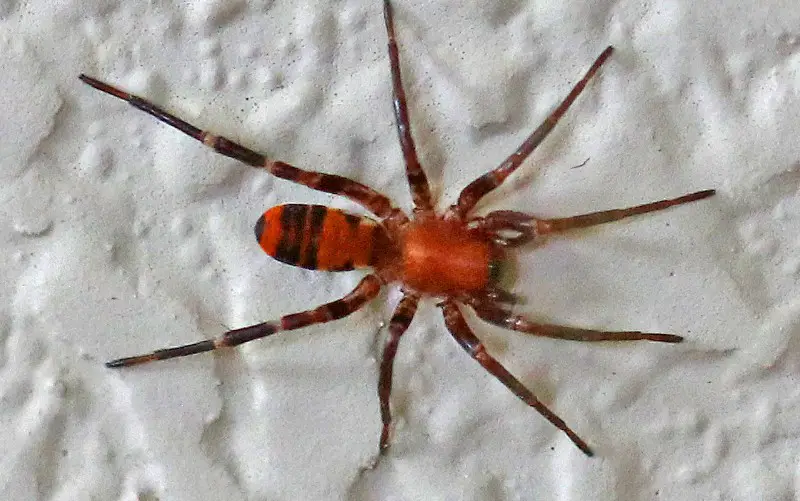
The Prairie Ant-mimic Sac Spider (Castianeira alteranda) is known for its striking ant-like appearance and varied color combinations. Most morphs feature red and black or brown and black coloring, with the top of the cephalothorax and abdomen red and lateral black bands across the body.
This mimicry helps them approach ant nests, as ants are a common food source. Some variations of this spider also come in black and white, further enhancing their resemblance to ants for effective hunting.
Big-eyed Thick-jawed Spider
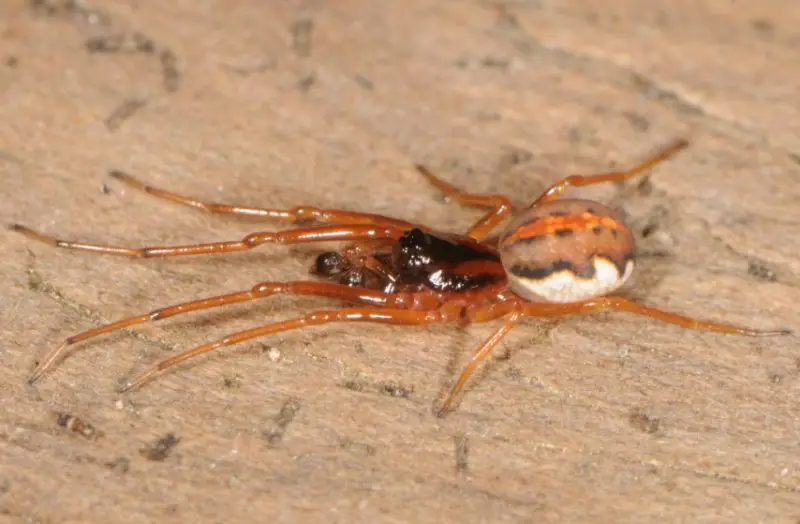
The Big-eyed Thick-jawed Spider (Pachygnatha autumnalis) exhibits a variety of colors, with a common red morph characterized by a dark red cephalothorax and a light red abdomen. The legs are also light red, and the abdomen often features orange or red-brown markings.
Additionally, these spiders may display white stripes on the sides and an orange or red line along the central section of the abdomen. Although small, this red stripe can create a resemblance to Red Widows, making identification interesting within its habitat.
Openfield Orbweaver
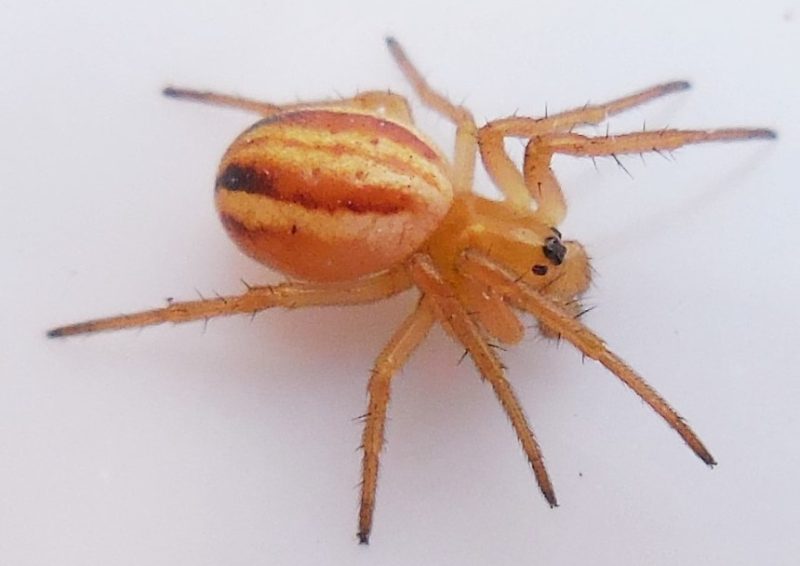
The Openfield Orbweaver (Araneus pratensis) is a member of the Araneae family, commonly found in the U.S. and Southern Canada. This species features a red abdomen adorned with white vertical stripes, along with a pale red cephalothorax and red legs. Its round, dome-shaped abdomen sets it apart from other orbweavers.
Frequently spotted around homes, these spiders often venture indoors in search of food. Typically, it is the larger females that make their way inside, while the smaller males are less frequently observed.
Walckenaer’s Studded Triangular Spider
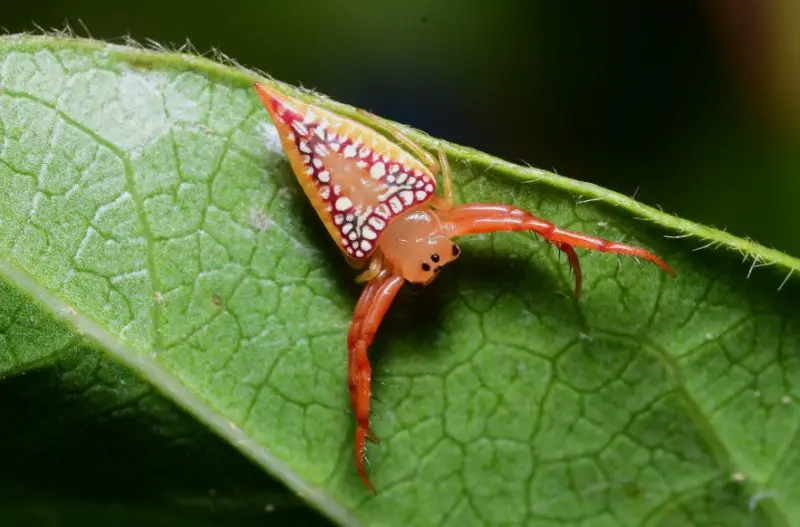
Walckenaer’s Studded Triangular Spider (Arkys walckenaeri) is a triangular-shaped spider known for its striking coloration, predominantly red. This species features a red cephalothorax and red legs, while its uniquely shaped abdomen displays a vibrant mix of red, white, blue, and yellow hues. Black bristle-like hairs adorn the front legs, enhancing its distinct appearance.
Some individuals may have rear legs that differ in color, with variations including red or green. The irregular color pattern on the abdomen stands out, with white being the dominant shade in this striking spider’s design.
Shamrock Orbweaver
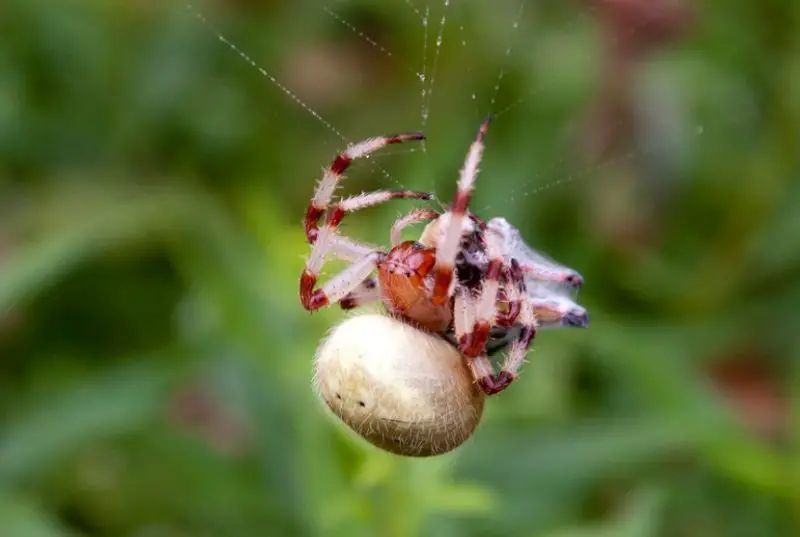
The Shamrock Orbweaver (Araneus trifolium) is commonly found in U.S. grasslands and is notable for its red coloration. This species features a wide red abdomen adorned with white or red spots and has white and black striped legs.
Shamrock Orbweavers are skilled builders of vertical spider webs, typically found among grass and other vegetation. They remain connected to their webs via a single silk line, waiting just above the ground for prey to become ensnared.
Living up to a year, these spiders are often found in gardens and prairies. While they can bite when handled roughly, their mild venom poses little threat to humans, being primarily harmful to small insects.
Rubens Orbweaver
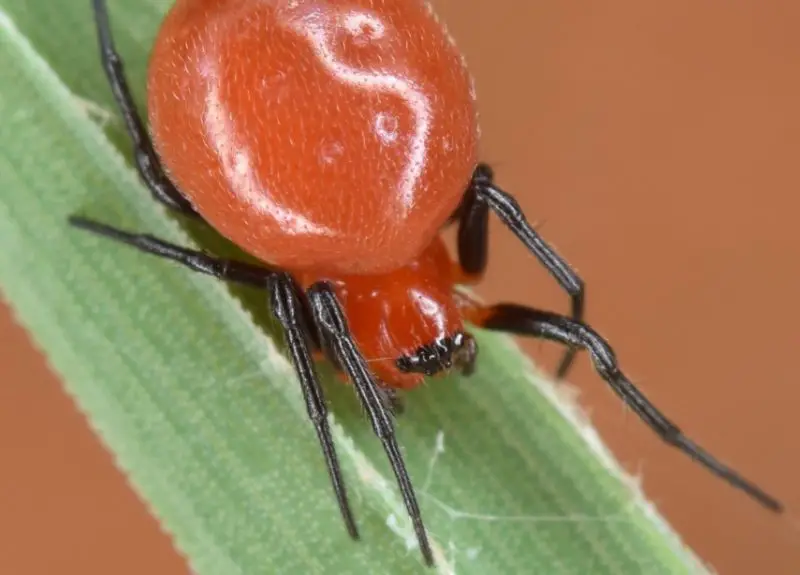
The Rubens Orbweaver (Hypsosinga rubens) is a versatile spider species known for its varied coloration. A common sight is its uniform red body, often paired with black legs. Additionally, it can be found in red-brown or tan morphs, with some individuals exhibiting a red body and legs along with a dark brown head and rear abdomen.
The spider’s coloration is influenced by its habitat, and gender plays a role, as males tend to have a more consistent red hue. Smaller than many other red spiders in the U.S., males typically reach a maximum size of 3.5mm.
Red-bellied Jumping Spider
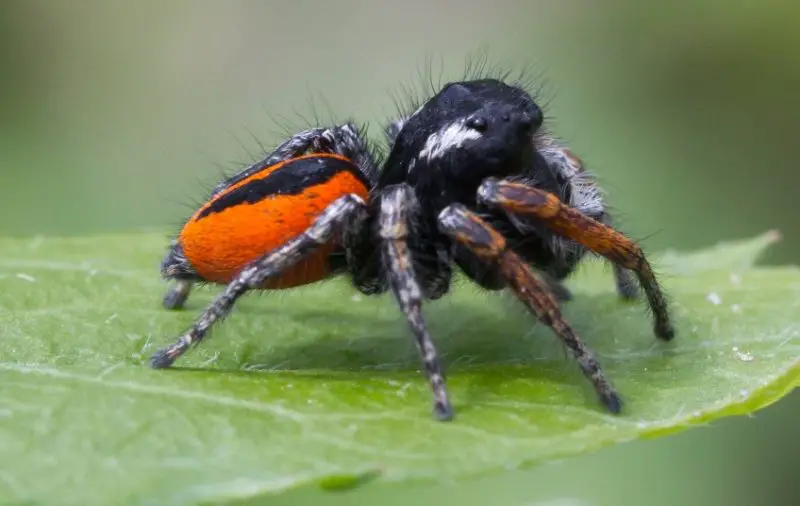
The Red-bellied Jumping Spider (Philaeus chrysops) is named for its striking orange-red underbelly, contrasting with its black top. This species exhibits a size range, with females growing between 7 to 12 mm, while males are smaller, averaging around 5 mm.
The red front legs of the spider become particularly noticeable during mating rituals, where females tap the ground with these legs as a courtship display to signal approval of potential mates.
Typically found on rocky terrains, Red-bellied Jumping Spiders are known for their distinctive coloration and engaging courtship behaviors.
Johnson’s Jumping Spider

Johnson’s Jumping Spider (Phidippus johnsoni), also known as the red-backed jumping spider, is characterized by its striking red abdomen and black body, including its legs. There are subtle color differences between the sexes: females feature a central black stripe on their red abdomen, while males typically have a more uniform red abdomen.
This species mimics the coloration of red multillid wasps, which may deter predators, and can be confused with other similarly colored spiders, including the venomous Redback spider. Johnson’s Jumping Spiders are versatile and can be found in a variety of habitats, ranging from low to high altitudes during daylight hours.
Whitman’s Jumping Spider
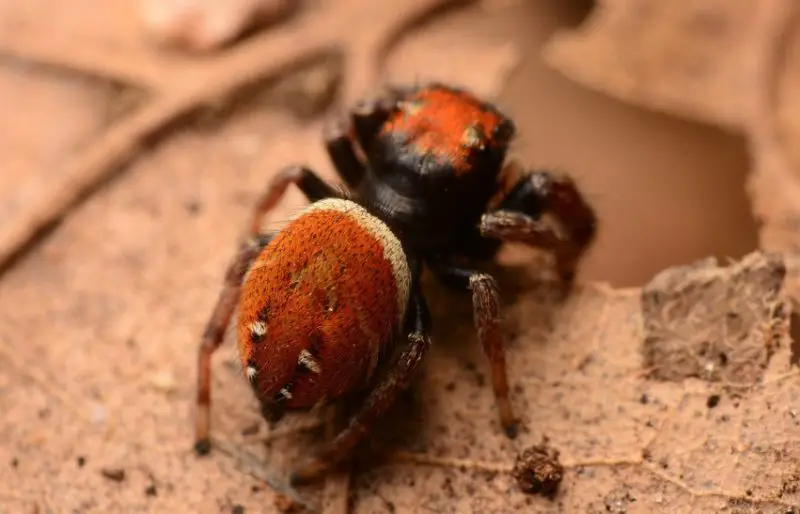
Whitman’s Jumping Spider (Phidippus whitmani) is recognized for its vibrant red coloration, particularly prominent in males, which feature a red cephalothorax and abdomen, with forelegs that may also be red. In contrast, females are primarily brown or brown-gray. Native to the Eastern United States, these spiders prefer mixed forests as their habitat.
Typically growing to about 0.42 inches, Whitman’s Jumping Spiders are known for their active hunting style, pouncing on prey instead of constructing webs. While not venomous, their bites can be painful, causing skin redness and rashes. This genus is notable for its longevity, with individuals living up to 2 years in hardwood forests.
Apache Jumping Spider
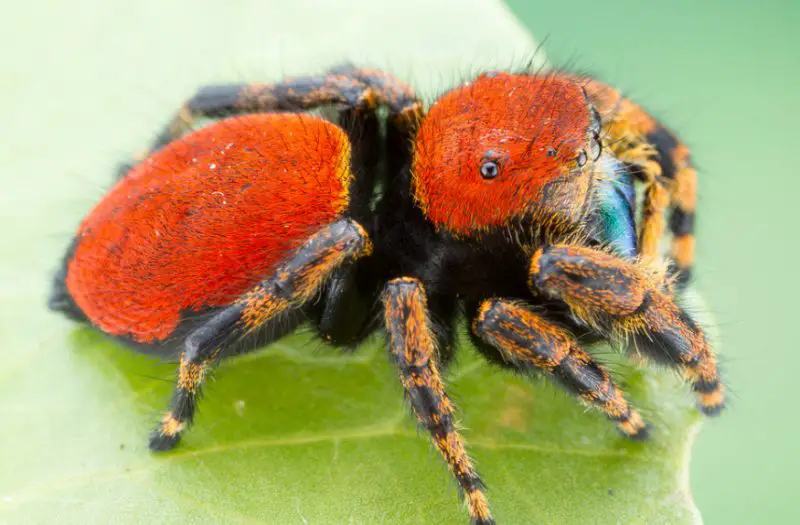
The Apache Jumping Spider (Phidippus apacheanus) is known for its vibrant dorsal colors, which can be either red or yellow, contrasting with a black underside. Both male and female spiders display this striking coloration, although females feature a distinct black central line on their abdomen. Size varies significantly among individuals, with small males measuring just 3mm and larger females reaching up to 22mm.
These colorful spiders thrive in desert and dry grassland habitats, often found hiding among bushes or cacti at various elevations.
Cardinal Jumping Spider
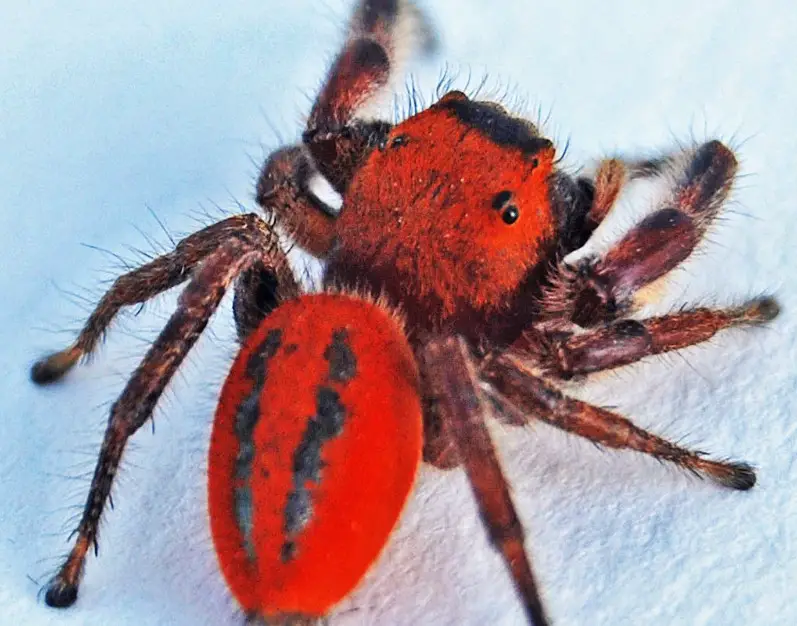
The Cardinal Jumping Spider (Phidippus cardinalis) is a striking spider species known for its mimicry of multiliid wasps. Males exhibit a vivid red coloration, while females are characterized by their orange-red hue. Male spiders possess a black underside, in contrast to the brown underside of females.
This genus does not spin webs; instead, they rely on their agility to leap onto prey. Smaller male Cardinal Jumping Spiders are often preyed upon by various species, including birds. Common throughout North America, these spiders primarily feed on small flies and crickets.
Red Weaver Ant-mimicking Spider
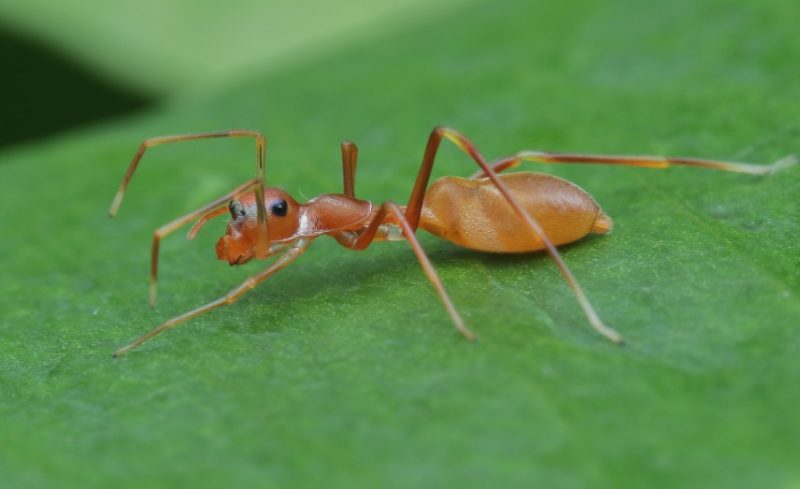
The Red Weaver Ant-mimicking Spider (Myrmaplata plataleoides) is renowned for its striking resemblance to the Asian Weaver ant, both in color and shape, making it difficult to identify as a spider. This mimicry enables these spiders to inhabit ant colonies, providing protection from predators that avoid the bad-tasting ants.
Although they mimic ants, they still spin webs, often constructing them on ground-level leaves for shelter and to ambush prey. Males can engage in battles using their long fangs and exhibit ant-like movement, although they rarely jump, reserving this skill for specific situations.
Slender Ant-mimic Jumping Spider
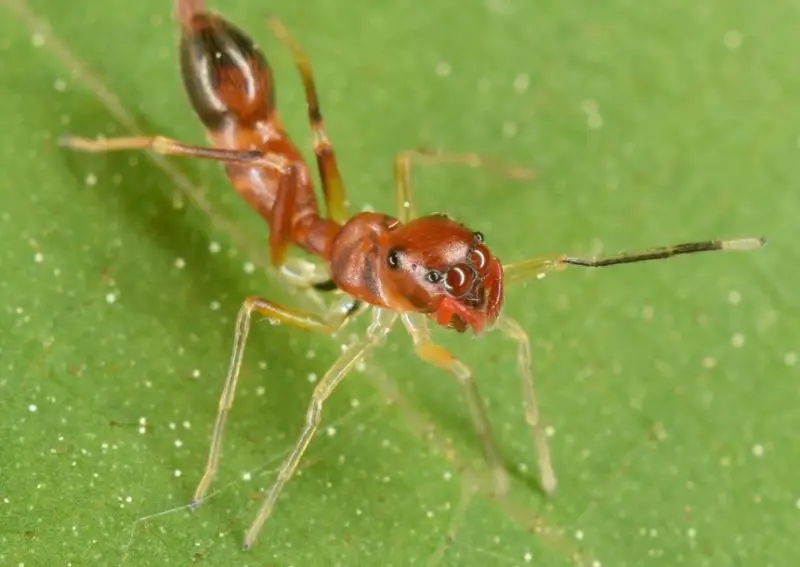
The Slender Ant-mimic Jumping Spider (Synemosyna formica) is a small spider known for its remarkable mimicry of ants in both color and shape, featuring a dark red hue and an elongated body that resembles an ant. Its diminutive size and ant-like appearance help deter potential predators.
While it can move like both an ant and a spider, its long, slender legs mimic ant legs, with the front legs functioning as antennae. With three rows of eyes, this spider can effectively navigate its environment.
Unlike other spiders, it doesn’t spin webs; instead, it prefers to ambush prey by stealthily crawling closer rather than jumping, which might reveal its true identity.
Long-horned Orbweaver
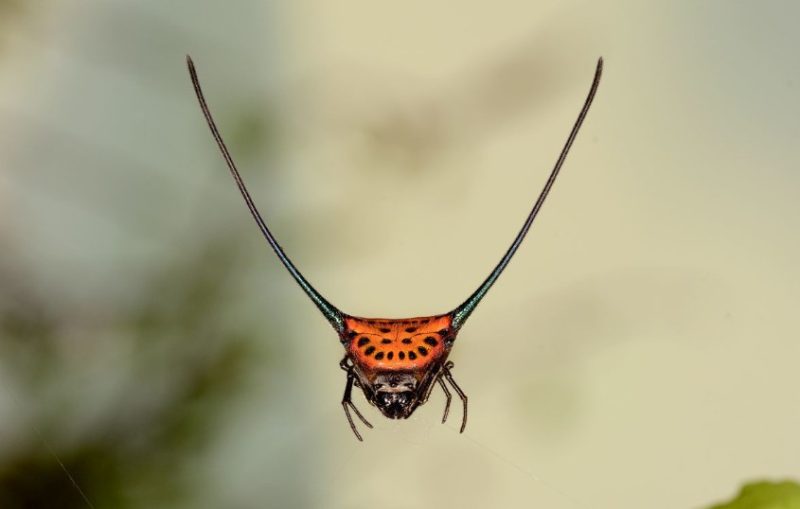
The Long-horned Orbweaver (Macracantha arcuata) is a striking red spider recognized for its long, curved spines protruding from its triangular abdomen. Its dorsal coloration is a vibrant red, contrasting with a ventral color that can be yellow or black. This species features small black dots along the edges of its abdomen, with four additional central dots for further distinction.
Females are notably larger, growing up to 9mm, while males measure around 1.5mm and often display a black abdomen instead of red. These unique characteristics make the Long-horned Orbweaver a fascinating sight in its habitat.
Ant-Like Crab Spider
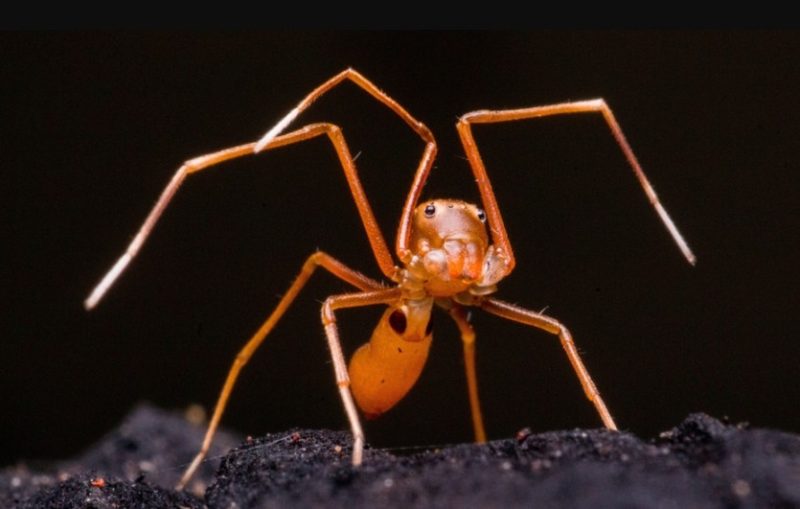
The Ant-Like Crab Spider (Amyciaea forticeps) is a remarkable mimicking spider that closely resembles ants, showcasing red, tan, and brown morphs. It cleverly raises its front legs to mimic antennae, enhancing its disguise.
Characterized by two large black spots on its lower abdomen, this spider has long, slender legs, allowing it to move slowly like its ant counterparts. Commonly found on farmlands where ants thrive, the Ant-Like Crab Spider blends in with these insects to avoid predators.
While it shares its habitat with ants, it preys on small insects rather than consuming sugary foods like fruit.
Fighting Spider
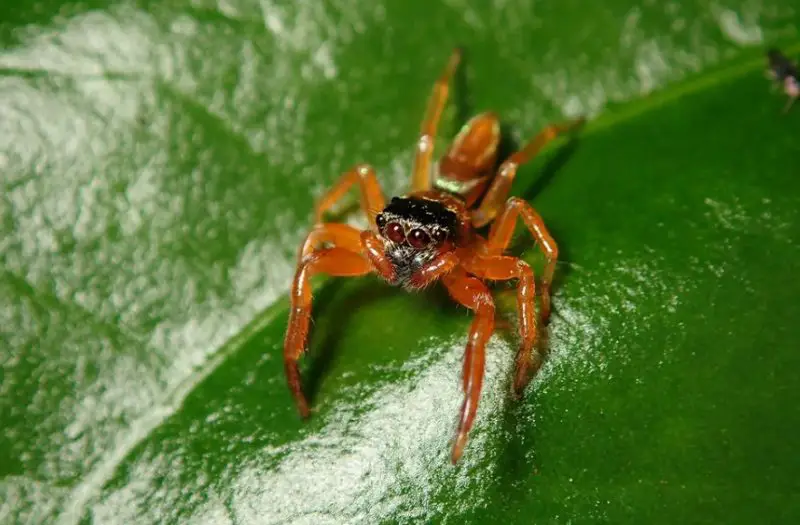
The Fighting Spider (Thiania suboppressa) is a strikingly colorful species known for its vivid hues, particularly the red morph with orange undertones that make it easily noticeable. Its coloration is not uniform; the cephalothorax exhibits dark red shades with a brown mark on the head, while the abdomen displays lighter red tones. This color variation extends to its legs, with the front four legs being dark red and the rear legs a lighter shade.
Notably, Fighting Spiders can leap several times their body length, showcasing their agility and dynamic movements.


